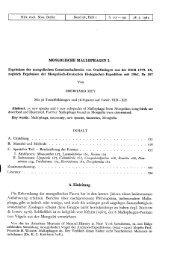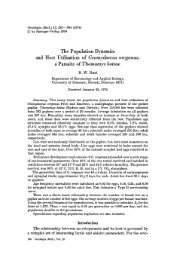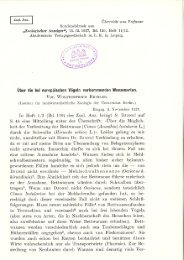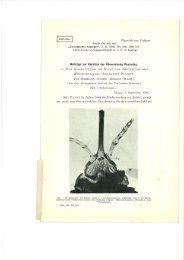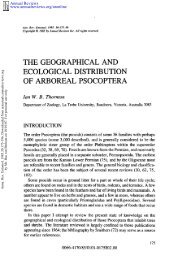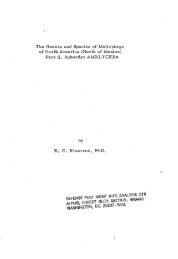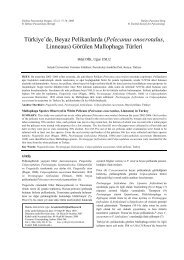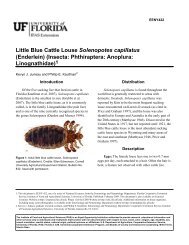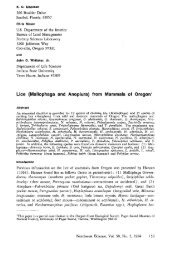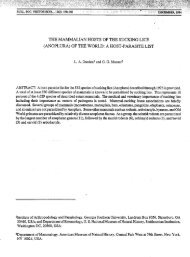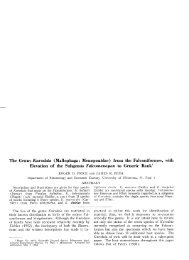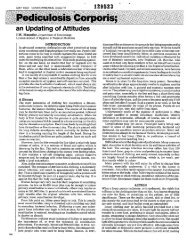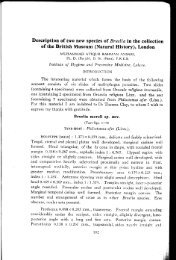Phthiraptera (Amblycera and Anoplura) parasites of the Family ...
Phthiraptera (Amblycera and Anoplura) parasites of the Family ...
Phthiraptera (Amblycera and Anoplura) parasites of the Family ...
You also want an ePaper? Increase the reach of your titles
YUMPU automatically turns print PDFs into web optimized ePapers that Google loves.
116<br />
Introduction<br />
The South American mammalian fauna contains<br />
an ancient (Oligocene) <strong>and</strong> diverse lineage <strong>of</strong><br />
Caviomorph rodents. They have distinctive characters<br />
such as <strong>the</strong>ir dental formula (1/1, 0/0, 1/1,<br />
3/3), small litter size, long gestation period, <strong>and</strong><br />
precociality; <strong>the</strong>y are also herbivores <strong>and</strong> live<br />
mainly in burrows (WOODS 1982, REDFORD &<br />
EISENBERG 1992). The family Octodontidae ranges<br />
in weight from 100 to 300 g, has a simplified<br />
occlusal pattern in <strong>the</strong> shape <strong>of</strong> an 8, <strong>and</strong> is<br />
distributed from southwestern Peru to sou<strong>the</strong>rn<br />
Chile <strong>and</strong> Argentina. It includes desert adapted<br />
rodents <strong>and</strong> also fossorial <strong>and</strong> semifossorial species<br />
(CONTRERAS et al. 1987). The Abrocomidae<br />
is a monotypic family (genus Abrocoma) whose<br />
species range from 200 to 300 g, <strong>and</strong> is found<br />
from Peru to central Chile <strong>and</strong> Argentina. These<br />
species have s<strong>of</strong>t fur, short limbs, <strong>and</strong> large ears<br />
<strong>and</strong> tails (REDFORD & EISENBERG 1992; SPOTORNO<br />
& WALKER 2000). The diverse family Ctenomyidae<br />
includes <strong>the</strong> single genus Ctenomys,<br />
adapted for a fossorial life, with a very short tail,<br />
small eyes <strong>and</strong> ears, <strong>and</strong> very long front claws.<br />
Ctenomys is distributed from sou<strong>the</strong>rn Peru <strong>and</strong><br />
Brazil to Tierra del Fuego (CONTRERAS et al. 1987,<br />
REDFORD & EISENBERG 1992).<br />
Parasites from <strong>the</strong> order <strong>Phthiraptera</strong> are poorly<br />
studied in Chile. For <strong>the</strong> Octodontidae <strong>the</strong>re are<br />
reports <strong>of</strong> Gyropus parvus WERNECK, 1936 in<br />
Octodon degus MOLINA, 1782 (WERNECK 1951);<br />
G. elongatus CASTRO, CICCHINO & TORRES-MURA,<br />
1987 in Aconaemys fuscus WATERHOUSE, 1842<br />
(CASTRO et al. 1987), <strong>and</strong> G. distinctus CASTRO &<br />
CICCHINO, 2002 in O. degus <strong>and</strong> O. lunatus OS-<br />
GOOD, 1943 (CASTRO & CICCHINO 2002). For <strong>the</strong><br />
family Ctenomyidae, WERNECK (1948) reported<br />
Ph<strong>the</strong>iropoios pollicaris EWING, 1924 in Ctenomys<br />
magellanicus BENNET, 1836 <strong>and</strong> CASTRO et al.<br />
(1987) reported G. p. parvus in C. magellanicus.<br />
For <strong>the</strong> family Abrocomidae, WERNECK (1948)<br />
reported Gyropus longus NEUMANN, 1912 in<br />
Abrocoma bennetti WATERHOUSE, 1837 <strong>and</strong> PRICE<br />
& TIMM (2000) reported Abrocomophaga<br />
chilensis EMERSON & PRICE, 1976 for <strong>the</strong> same<br />
host.<br />
Materials <strong>and</strong> methods<br />
L Moreno Salas et al.: <strong>Phthiraptera</strong> <strong>parasites</strong> <strong>of</strong> rodents from Chile<br />
All rodent specimens analyzed were from <strong>the</strong> collections<br />
<strong>of</strong> <strong>the</strong> National Museum <strong>of</strong> Natural History in Santiago,<br />
Chile. The lice were collected from <strong>the</strong> following species:<br />
51 specimens <strong>of</strong> Octodon degus, distributed from Huasco<br />
(28° 28’ S; 71° 13’ W) to Santiago (33º 27’ S; 70º 38’<br />
W), three Octodon lunatus from National Park Fray<br />
Jorge (30° 39’ S; 71° 40’ W) <strong>and</strong> Peñuelas National<br />
Reserve (33° 09’ S; 71° 32’ W), 19 Aconaemys fuscus<br />
distributed from Baños del Flaco (35° 57’ S; 70° 26’ W)<br />
to Vilches National Reserve, nine Aconaemys sagei from<br />
Malleco Lagoon (38° 12’ S; 71° 50’ W) <strong>and</strong> Paso Reigolil<br />
(39º 07’S; 71º 25’ W), 15 Octodontomys gliroides<br />
distributed from Zapahuira (18° 20’ S; 69° 36’ W) <strong>and</strong><br />
Chuzmiza (19° 41’ S; 69° 11’ W). For <strong>the</strong> family<br />
Ctenomyidae, <strong>the</strong>re were five Ctenomys maulinus from<br />
Maule Lake (36° 04’ S; 70° 30’ W), four Ctenomys<br />
magellanicus from Tierra del Fuego (54° 04’ S; 68° 57’<br />
W), <strong>and</strong> three Ctenomys opimus from Japu Bajo (18°<br />
24’ S; 69° 16’ W). For <strong>the</strong> family Abrocomidae, 13<br />
specimens <strong>of</strong> Abrocoma bennetti distributed from Huasco<br />
to Itata River (36° 50’ S; 72° 24’ W) were examined.<br />
The recovered <strong>Phthiraptera</strong> were stored in alcohol, <strong>and</strong><br />
for better identification <strong>the</strong>y were later mounted<br />
according to PALMA (1978). The lice are deposited in<br />
<strong>the</strong> collection <strong>of</strong> <strong>the</strong> Laboratory <strong>of</strong> Zoology, Faculty <strong>of</strong><br />
Veterinary Medicine, University <strong>of</strong> Concepción, Chillán,<br />
Chile. The material was collected by LUCILA MORENO<br />
SALAS <strong>and</strong> DANIEL GONZÁLEZ-ACUÑA.<br />
Results<br />
Suborder <strong>Amblycera</strong><br />
<strong>Family</strong> Gyropidae<br />
Genus Gyropus NITZSCH, 1818<br />
Gyropus elongatus CASTRO, CICCHINO & TORRES<br />
MURA, 1987<br />
Type host: Aconaemys fuscus WATERHOUSE, 1842<br />
O<strong>the</strong>r host: Aconaemys sagei PEARSON, 1984<br />
(CASTRO et al. 1987)<br />
Examined: 19 Aconaemys fuscus, positive to lice<br />
six, from El Flaco Hot Springs, Las Cabras (34º<br />
38’ S; 70º 41’ W) <strong>and</strong> Vilches National Reserve.<br />
Nine Aconaemys sagei, positive to lice three, from<br />
Malleco Lagoon <strong>and</strong> Paso Reigolil.<br />
Material examined: three males, three females,<br />
three larvae (nymphs).<br />
Gyropus distinctus CASTRO & CICCHINO, 2002<br />
Type host: Octodon degus (MOLINA, 1782)<br />
O<strong>the</strong>r hosts: Octodon lunatus OSGOOD, 1943<br />
(CASTRO & CICCHINO 2002)<br />
Examined: 51 O. degus, animals positive to lice<br />
13, from Los Dominicos (33º 27’ S; 70º 38’ W),<br />
Coquimbo (29º 57’ S; 71º 22’ W), National Park



